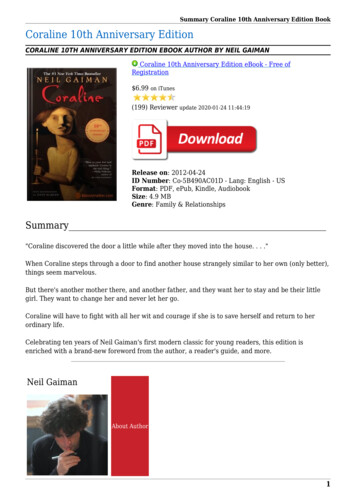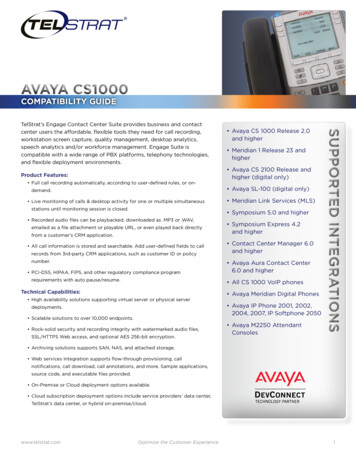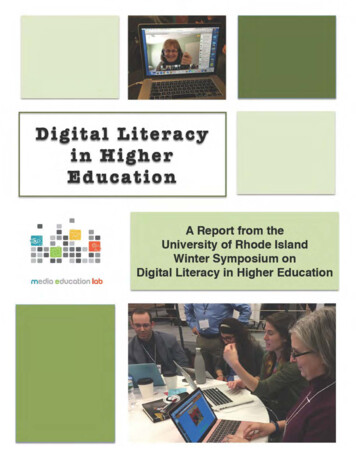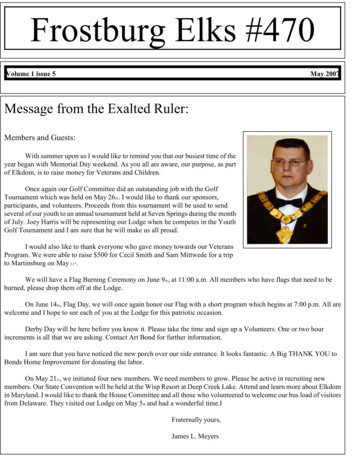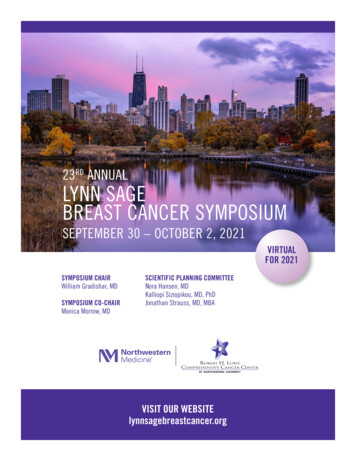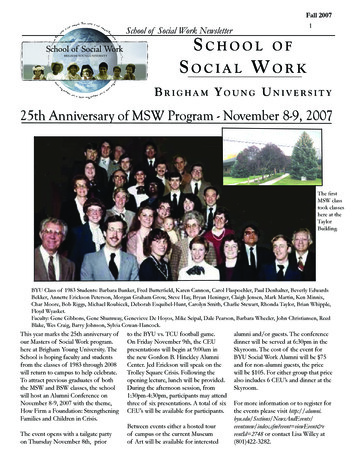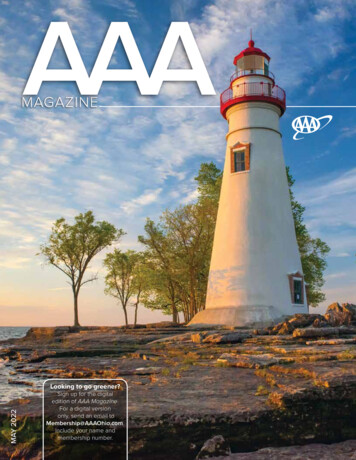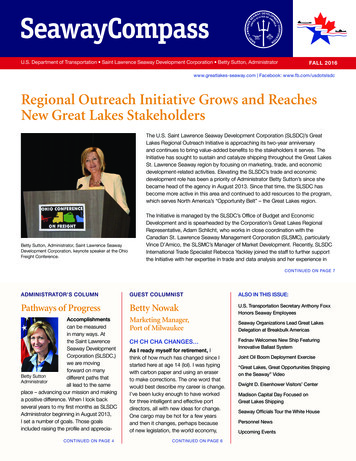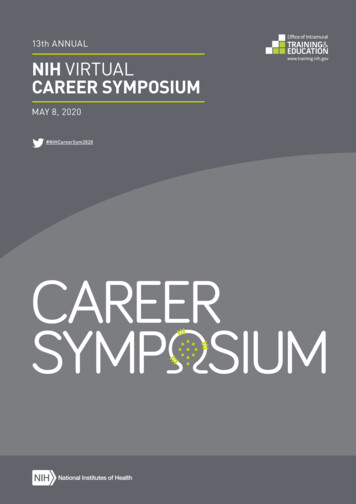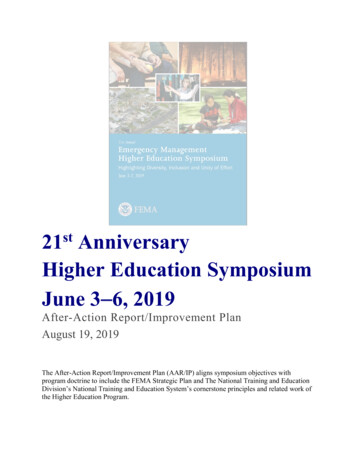
Transcription
21st AnniversaryHigher Education SymposiumJune 3 6, 2019After-Action Report/Improvement PlanAugust 19, 2019The After-Action Report/Improvement Plan (AAR/IP) aligns symposium objectives withprogram doctrine to include the FEMA Strategic Plan and The National Training and EducationDivision’s National Training and Education System’s cornerstone principles and related work ofthe Higher Education Program.
Table of ContentsSymposium Overview .1Logistics & Planning .2Symposium Content .5Community Resource Sharing .9Successes & Areas for Improvement. 15Appendix A: Improvement Plan . A-1Appendix B: Save-the-Date & Invitation . B-1Appendix C: Call for Abstracts & Posters and Scoring Rubric . C-1Appendix D: Student Volunteer Invitation/Criteria . D-1Appendix E: Community Resource Sharing Events . E-1Appendix F: Symposium Participants . F-1Appendix G: Symposium Program Agenda . G-1Appendix H: Participant Evaluation & Feedback Summary . H-1Appendix I: Hotwash . I-1Table of ContentsFEMA Higher Education Program
After-Action Report/Improvement Plan (AAR/IP)21st Annual Higher Education SymposiumTheme: Highlighting Diversity, Inclusion and Unity of EffortSYMPOSIUM OVERVIEWName & DateScope21st Annual Higher Education Symposium, June 3 6, 2019This Symposium is a four-day engagement for the Emergency Management (EM)Higher Education Community of Interest. Day one consists of various topicalworkshops and days two-four are comprised of plenary and breakout sessions toadvance the development and sustainment of EM Higher Education.Logistics &PlanningInvitations were shared via e-mail, the Higher Education Program website andnewsletter, as well as in the FEMA bulletin. The call for abstracts used a similaroutreach strategy. A review process for abstract selection was coordinated byexternal partners from the Information Sharing & Symposium Planning SpecialInterest Group. The Higher Education Program managed student and facultyvolunteers to support the logistics and event data collection.Symposium ThemeThis year’s theme was entitled “Highlighting Diversity, Inclusion and Unity ofEffort.”Symposium ContentSeven workshops were offered on the first day of the Symposium. The breakoutsessions provided more than 50 opportunities to learn about critical topics, programs,and research relating to EM and diversity, inclusion, and unity of effort.Additionally, an invaluable networking opportunity for colleges/universities,administrators, and students presented itself at the symposium.CommunityResource SharingThe Posters in the Pub contest encourages research and collaborative opportunitiesfor both students and faculty. The Share Fair, which features important relatedprograms, associations, and organizations also offers a great opportunity to connectand network. Both were held on Tuesday evening from 5:30-7:30 pm in the Pub,along with a dessert selection and coffee. An International Breakfast was heldWednesday morning to welcome international attendees. The Evening in the Librarywas held on Wednesday from 6:00-7:30 p.m., highlighting new books andpublications. Special Interest Group (SIG) meetings were held throughout theduration of the conference and were incorporated as breakout sessions.Successes & Areasof ImprovementSponsorParticipatingOrganizationsPoint of ContactSymposium OverviewThe areas for improvement will be based on feedback and analysis from theInformation Exchange and Symposium Planning Special Interest Group andcompleted participants evaluation forms.FEMA/NTED/NTES’s Higher Education Program263 participants registered to attend the Symposium, representing private and publicacademic intuitions, international academic institutions, federal agencies, nongovernmental agencies, EM scholars, FEMA personnel and some practitioners. Afull list of participating agencies in Appendix F.Wendy Walsh, Higher Education Program ManagerEmail: Wendy.Walsh@fema.dhs.gov Phone: (301) 447-12621FEMA Higher Education Program
After-Action Report/Improvement Plan (AAR/IP)21st Annual Higher Education SymposiumTheme: Highlighting Diversity, Inclusion and Unity of EffortLOGISTICS & PLANNINGFEMA’s Higher Education Program, located in the branch of the National Training and EducationDivision’s National Training and Education System, hosted the 21st Anniversary Higher EducationSymposium; a four-day event held at the Emergency Management Institute, located at the NationalEmergency Training Center in Emmitsburg, MD.In November, more than 60 international contacts were sent an electronic “Save-the-Date”invitation, which included the application for admission. The engagement’s domestic invitationpackage, which included a formal electronic invitation and application, was distributed in Decembervia email to more than 990 participants. A total of 1,054 invitations were distributed for the 21stAnniversary Emergency Management Higher Education Symposium. Invitees were contacts fromcolleges and universities on the College List, professional organizations, and 2018 Symposiumattendees. Other invitations were sent through May to: federal, state, and local government agenciesincluding all FEMA regions, persons by request, keynotes, and recommended presenters.A total of 263 participants were recorded through the TIAS roster as attending the Symposium(course E-0392). The actual total is higher, as some FEMA leadership, plenary speakers, andbreakout presenters did not complete the application and instead utilized daily security access.The planning of the Annual Symposium was interrupted in December due to the shutdown of theFederal Government, which lasted 22 days.INTERNATIONAL PARTICIPANTSThere were 23 international participants representing ten different countries. The breakdown was asfollows: Canada – 1 England – 1 India – 1 South Korea – 1 Sweden – 3 Taiwan – 6 Turkey – 7 United Kingdom – 2 Uruguay – 1Additionally, the following plenary/breakout sessions were presented by international participants: Hsien-Ho (Ray) Chang, Ph.D., Oklahoma State University1. Research & Theory Special Interest Group (breakout)Jack Rozdilsky, Ph.D., York University1. Threats to EM Program Sustainability: Downsizing and Elimination (breakout)Christian Uhr, Ph.D., Lund University1. Incorporating Research into Teaching (plenary)Symposium Overview2FEMA Higher Education Program
After-Action Report/Improvement Plan (AAR/IP)21st Annual Higher Education SymposiumTheme: Highlighting Diversity, Inclusion and Unity of EffortSTUDENT VOLUNTEERSThere was a total of 18 student volunteers from the following colleges and universities: American Public UniversityArkansas State UniversityJohn Jay CollegeMetropolitan College of New YorkMonmouth University Pennsylvania State UniversitySaginaw Valley State UniversityThomas Jefferson UniversityUniversity of California, Santa CruzWith the assistance of student volunteers and under the direction of the Program Assistant, theSymposium ran efficiently. Each student submitted their required 2-3-page synopsis per breakoutassignment within the deadline. Students were also expected to serve as session reporters, handout microphones during plenary session Q&A’s, register Symposium participants, take notes,and support the High Ed Program Manager and Program Support Staff for the week. Thestudents had positive attitudes, were enthusiastic, and participated in sessions when not workingwith the High Ed Program Staff. All students acclimated very quickly to the Symposiumatmosphere and took initiative to perform duties without being asked.ABSTRACT SELECTION PROCESS FOR PRESENTATIONSLast year, to improve the abstract selection process and ultimately the quality and relevance ofthe presentation submissions, a categorization of topic tracks was incorporated into thesubmission requirements and guidelines. As required last year, each submission had to beapplicable to the theme of Diversity, Inclusion and Unity of effort, and then fall into one of thefollowing three categories: Scholarship of Teaching and Learning (SoTL) in EmergencyManagement, Research Methodology and Integration, or Policy and Administration ofEmergency Management Programs.The FEMA Higher Education Program Manager has historically been the SIG lead for theInformation Exchange and Symposium Planning SIG. However, since the Federal Governmentshutdown was anticipated to interrupt the planning timeline and specifically, the abstractsubmission and selection process, a co-lead was appointed to handle all tasks while the shutdownensued. Dr. Jamie Earls, Arkansas Tech University, took on the assignment to organize thesubmissions and assign them to a reviewer. To make this process efficient and organized, eachtrack was assigned a lead reviewer from the Information Exchange and Symposium PlanningSIG. The track lead was responsible for choosing at least three additional reviewers andmanaging the review process for all submissions applicable to that track. This enabled the SIG toleverage broader support from the Higher Education community in choosing the bestpresentations for the Symposium. Dr. Goulda Downer, Howard University, led the researchtrack; Dr. Claire Knox, University of Central Florida, led the SoTL track; and Dr. Sandy Smith,Arkansas Tech University, lead the administration track. Together, the Program Manager andtrack leads created a scoring rubric and proceeded with a blind review process. The Call forSubmissions was announced on February 8th via email and through the Program’s website andNewsletter. The deadline to submit was March 15, 2019. There was a total of 49 submissions,three more than last year.Symposium Overview3FEMA Higher Education Program
After-Action Report/Improvement Plan (AAR/IP)21st Annual Higher Education SymposiumTheme: Highlighting Diversity, Inclusion and Unity of EffortLOCAL COMMUNITY INVOLVEMENTThe Maryland State Police Honor Guard Platoon executed the Presentation of Colors whichinitiated the start of the Symposium on the morning of Tuesday, June 4, 2019. The Presentationwas followed by the singing of the National Anthem, performed by a portion of Mrs. Kirby’sfirst grade classes from Mother Seton School, a private primary and secondary school locatedbehind the NETC campus in Emmitsburg, MD. The children also led the Pledge of Allegianceand received an enthusiastic welcome afterwards.Mother Seton School students leading the National Anthem & Pledge of AllegianceEVALUATIONSDr. Bernard Jones, St. John’s University, and Dr. Sandy Smith, Arkansas Tech University againled the evaluation effort for the Symposium. Both are members of the Symposium Planning andInformation Exchange Special Interest Group. The paper evaluations were implemented forMonday workshops, each daily plenary, and both breakout sessions each day. The color-codedpaper system was used again for organizational purposes.To incentivize the completion of the evaluations, a donation of prizes was organized and raffledoff each morning. When a participant submitted a completed evaluation, he/she was provided thestub of a ticket that was entered into the daily drawing. Drawing were held and winnersannounced at the Wednesday and Thursday morning plenary sessions. Prizes were mostlycomprised of books and school swag.Dr. Jones conducted an evaluative analysis of the responses which can be found, along with theevaluation questions, averages and written feedback, in Appendix H.Symposium Overview4FEMA Higher Education Program
After-Action Report/Improvement Plan (AAR/IP)21st Annual Higher Education SymposiumTheme: Highlighting Diversity, Inclusion and Unity of EffortSYMPOSIUM CONTENTTHEMEThe theme this year was “Highlighting Diversity, Inclusion and Unity of Effort.” Theoverarching goals of the engagement were to: 1) host dialogues to facilitate the refinement of thebody of knowledge that has been rooted in 21 years of passionate development; 2) offerworkshops and breakout sessions to hone the instructional, research and program developmentskills of faculty; 3) present “elders” from the community to mentor faculty and students; and 4)strategically look forward to develop the emergency management academic discipline.PRE-CONFERENCE WORKSHOPSSeven pre-conference workshops were offered to Symposium participants on Monday, June 3,2019. They were:1. Mapping, Modeling and Communicating Disaster Information Using GISPresenter: Kevin Mickey, Ph.D.2. CommunityPresenter: Lee Rush3. What to Teach in Emergency ManagementPresenter: Dave McEntire, Ph.D.4. Integrating the Next Generation Core Curriculum into Your Assessment and AccreditationStrategyPresenters: Jamie Earls, Ph.D.; Carol Hackerott, Ph.D.; Sandy Maxwell Smith, RN, Ph.D.5. College/Underserved Community Partnership Program (CUPP)Presenters: Michael Burns and Etienna Winzer6. Mindfulness and PurposePresenter: Leah Weiss, Ph.D. MSW7. How to Teach Emergency ManagementPresenter: David McEntire, Ph.D.PLENARY SPEAKERS18 Plenary Speakers presented over three mornings. Speakers were selected as they wererelevant to the theme of Diversity, Inclusion, and Unity of Effort. The plenary sessions were asfollows:Tuesday:1.2.3.4.5.6.Michael Sharon –Deputy Superintendent, Emergency Management Institute (EMI)Wendy Walsh – Program Manager, FEMA Higher Education ProgramJo Linda Johnson, Esq. –Director, FEMA Office of Equal RightsAaron Titus, J.D. –Author, How to Prepare for EverythingJessica Jensen, Ph.D. –Professor, North Dakota State UniversityJerry Murphy, J.D., AICP, CFM –Resilient Communities Initiative at University ofFlorida7. Christian Uhr, Ph.D. –Lecturer, Swedish Defense UniversitySymposium Overview5FEMA Higher Education Program
After-Action Report/Improvement Plan (AAR/IP)21st Annual Higher Education SymposiumTheme: Highlighting Diversity, Inclusion and Unity of Effort8. Marccus D. Hendricks, Ph.D. –Professor, Maryland Institute for AppliedEnvironmental HealthWednesday:9. Carlos J. Castillo, CEM –Associate Administrator, FEMA Office of Resilience10. Dan Paulette Chapman –NTES Branch Chief, FEMA11. Matthew Prager –Chief, FEMA Curriculum Standards and Instructional TechnologyBranch, EMI12. DeeDee Bennett, Ph.D. –Associate Professor, SUNY Albany13. Gianina Baker, Ph.D. –Assistant Director, National Institute for Learning OutcomesAssessment (NIOLA)Thursday:14. Stephanie Yanta –Supervisory Special Agent, Federal Bureau of Investigation (FBI)15. Scott Kelberg –Acting Directory for FEMA National Training and EducationDivision (NTED)16. Martha D. “Marty” Shaub, CEM –President, International Association ofEmergency Managers (IAEM)17. Jeff Stern, Ph.D. –State Coordinator, Virginia Department of EmergencyManagement18. Kevin Clement, CEM –Faculty, University of HoustonBREAKOUT SESSIONSThe three-day conference hosted 50 Breakout Sessions covering a wide variety of topicsincluding community abstract submissions, educational level sessions, FEMA-led sessions, focusgroup report-outs, Special Interest Groups and unique community sessions. Presenters wereassigned to submit a one-page synopsis of their breakout session for a compilation ofproceedings document that will be made available to the community and serve as a historicaldocument of the event. Specifically, the breakout sessions were:Tuesday:1. Race, Ethnicity, & Economic Impacts Special Interest Groups2. The Current State of University-Based Disaster Management Courses in the U.S. Opportunities3. Job Placement of Recent Emergency Management Graduates4. The Benefits and Challenges of Living, Teaching, and Working in Today’s DiverseWorld: Revisited5. Disaster Field Course6. University Youth Leadership in Hurricane Recovery in the Virgin Islands7. Are Higher Education Programs Incorporating FEMA’s Next Generation CoreCompetencies?8. Writing EM Case Studies for Use in Academic Settings – A Look at the RhodeIsland Night Club Fire Preparedness as a Case Study Teaching Template9. Case Teaching and Learning Special Interest Group10. Merging Academia and the Professions in Multidisciplinary Online GraduatePrograms11. Best Practices in Delivering Online, Advanced Emergency Management Courses12. Creating Multi-Course Program Assessment RubricsSymposium Overview6FEMA Higher Education Program
After-Action Report/Improvement Plan (AAR/IP)21st Annual Higher Education SymposiumTheme: Highlighting Diversity, Inclusion and Unity of Effort13. Collaborative Instructional Design14. Critical Infrastructure Organizational Resilience – A Focus on Law EnforcementFirst Responders15. Setting a Context for Discourse in the Emergency Services Classroom16. Develop (or Improve) and Emergency Management Internship Program17. FEWSION for Community Resilience: Understanding Critical Supply ChainsThrough Community EngagementWednesday:18. Scholarship of Teaching and Learning Special Interest Group19. Floodplain Management20. Storytelling – Enhancing Emergency Management Learning in Native Populations21. Threats to EM Program Sustainability: Downsizing and Elimination22. Analysis of Buyout Properties – Are the Headlined Correct?23. An Evaluation of Emergency Management Degree Programs Based on Skills24. Career Pathway Success: It Starts on Day One25. Student Perspectives & Academic Learning Special Interest Group26. Jobs and Internships Special Interest Group27. Research & Theory Special Interest Group28. Exploring the Current and Future Uses of Storytelling in Emergency ManagementEducation29. Disaster Health Core Curriculum30. Increasing Emergency Management Resilience in the Health Care and Public Sector31. Competent Action: Why We Should Care About Immersion and its Effect on theIndividual32. Using Manipulatives in the Higher Ed Classroom33. Building on Common Ground: Emergency Management and Homeland Security34. A Practitioner and Academic Based Assessment for Integrating Homeland Securityand Emergency Management35. Working with the Administration36. Higher Education Academy and FellowshipThursday:37. The Role of Emergency Management in the Early College Strategy38. 2-Year Programs SIG: Planning Resource for Developing a 2-Year EM AcademicProgram39. Ethics Special Interest Group40. Comprehensive Academic Program Review: Homeland Security and EmergencyManagement Degrees41. Building Cultures of Preparedness: Teaching & Learning Culture-Based Approachesin EM42. Integrating the Core Competencies of Resilience into Engineering Education43. Teaching, Tenure, and Dissertations: How Can I Possibly Accomplish Everything?44. Accreditation Special Interest Group45. New Program Resources & Support Special Interest Group46. Creating Change Agents: Developing Leadership Skills in the Classroom47. Diversifying Our Source of SolutionsSymposium Overview7FEMA Higher Education Program
After-Action Report/Improvement Plan (AAR/IP)21st Annual Higher Education SymposiumTheme: Highlighting Diversity, Inclusion and Unity of Effort48. Pracademics: Bridging the Gap Between Academics and Practitioners in EmergencyManagement49. Climate Security: A Pre-Mortem Approach to a Sustainable Global Future50. Resilience and Emergency Management: Exploring the Psychological Dynamics ofLeadership51. Understanding International Cultural Competencies in Disaster Planning andResponseGRAPHIC FACILITATOR & SINGING TREETo illustrate and capture the dialogue at the 21st Anniversary of the FEMA Higher EducationSymposium, a graphic facilitator was hired and present on stage for each morning plenary. Herartifacts were well-received and repurposed in programmatic material, like the programbrochure. Ms. Laurie Marshall; artist, teacher, and master collaborator, was invited back to theSymposium this year, creating at least a dozen oil pastel murals related to the content andconversation of each plenary session. Ms. Marshall has trained thousands of teachers in visualliteracy, led visual art and mural making workshops, facilitated leadership training and conflictprevention with NASA, the Department of Interior, the Army Corps of Engineers and nowFEMA. Some attendees last year noted that the sound of her drawing was distracting, as it waspicked up through the microphones onstage. This year she was moved from the stage to justbelow the stage, reducing the sound of her drawing considerably.Ms. Marshall also created a Singing Tree Mural for the Symposium last year, adding to aninternational Forest of 55 Singing Trees murals made by 18,000 people from 50 countries. Eachmural addresses a community challenge and brings forward unique and innovative solutions,honoring every voice and vision. All symposium participants were invited to contribute. Thisyear, the mural was on display, again, and attendees add to it.FEMA Higher Education Singing Tree in 2018 (left) and 2019 (right)Symposium Overview8FEMA Higher Education Program
After-Action Report/Improvement Plan (AAR/IP)21st Annual Higher Education SymposiumTheme: Highlighting Diversity, Inclusion and Unity of EffortCOMMUNITY RESOURCE SHARINGThe Symposium offers an optimal platform for information and resource sharing within theemergency management community, and beyond. Many networking opportunities were heldthroughout the week to facilitate the exchange of information including pre-conferenceworkshops (previously noted), a “Share Fair” and poster contest, an international breakfast, an“Evening at the Library” with tour and author networking, and the convening of several SpecialInterest Groups (SIGs).SHARE FAIR AND POSTERS IN THE PUBThe “Posters in the Pub” and “Share Fair” events were hosted as they were last year, in theStudent Resource Center (also known as “The Pub” on the NETC Campus), accompanied bycoffee and dessert selections for attendees and participants. The events ran from 5:30 p.m. to7:30 p.m.Poster contestantsThe poster contest presents the opportunity to share research programs and collaborativeopportunities among presenters and participants, as well as offers the opportunity to network.There were 8 entered into the contest. Each poster combines a graphic display of the presentedmaterial in a required template with specified learning outcomes and an opportunity toinformally discuss research with symposium attendees. Each poster was considered for the 2ndAnnual “Dr. Tom Phelan Outstanding Poster Award” and for the “People’s Choice Award.”Criteria for the Dr. Tom Phelan Outstanding Poster Award is selected by the FEMA HigherEducation Program Manager based on: 1) The poster addresses a current emergencymanagement problem; 2) The poster is well-organized; 3) The poster presenter conveys theresearch in a clear and concise manner, being able to answer questions regarding the area(s)presented; and 4) The poster or research conveys potential to promote synergy between theacademic and practitioner community.Symposium Overview9FEMA Higher Education Program
After-Action Report/Improvement Plan (AAR/IP)21st Annual Higher Education SymposiumTheme: Highlighting Diversity, Inclusion and Unity of EffortThe “People’s Choice Award” was determined by the highest number of votes received byattendees. All attendees were provided a voting ballot inside their Symposium package along withthe instruction to vote for one poster they felt was the best. A voting box was placed in the Pub toallow voters anonymity. Winners were recognized and congratulated for their achievement thefollowing morning during the plenary session.Participant1. Using Telemedicine to Bridge Health Disparities Gaps During DisasterResponseThomas Anglin, Chase Beecher, Monroe Molesky, Makenzie Hemmer,Sara Lesnesky2. Social Media’s Impact on Post-Disaster Response in LowSocioeconomic AreasShane Henry, Nahuel Juarez, Camron Ramirez, Willard RoseAffiliationAlma College3. Addressing Maternal Disaster Planning and Relief: Preparing Mothersfor Prenatal, Birth, and Postnatal Care During Disasters Brian Iveson,Jacob Philips, Anthony Pizzo, Blaire Showers4. Disproportionate Dental Care for Minorities in Post-Disaster AreasAlexander Henry, Aubrey Root, Gregg Hartman, Aaron Saenz, MeganBlanchard5. Crisis Communication in Systems K-12 School PrincipalsTomicka Williams6. IPE Service Learning Project Partnering Students, NGO’s and VillageStakeholdersBeatrice Nadine S. Fant, Alexa L. Van Hine, Rene HernandezAlma College7. Improvement of Disaster Exercise Planning and Conduct byModularization of Training FacilitiesWeiping Tsai, Yuansung JiangTaipei CityOffice ofDisasterManagementUniversity ofTexas RioGrande Valley8. Service-Learning to Promote Diversity, Inclusiveness, and Unity forDisaster ResiliencyDean KyneAlma CollegeAlma CollegePurdue GlobalUniversitySaginawValleyUniversityPoster submission listDean Kyne from the University of Texas Rio Grande won the Dr. Tom Phelan OutstandingPoster Award, while Alexander Henry, Aubrey Root, Gregg Hartman, Aaron Saenz, and MeganBlanchard, students from Alma College, were awarded the People’s Choice.Seventeen exhibitors; a combination of colleges and universities, organizations, centers, andagencies, had a presence at the “Share Fair” for the purpose of highlighting new and innovativeprograms, projects, activities, and events. Exhibitors began set-up at 4:45 p.m. and were requiredto disassemble at the conclusion of the event at 7:30 p.m. The event was well attended and manyof the exhibitors offered free giveaways in addition to informational resources at their tables. Theexhibitor list below outlines the “Share Fair” participants:Symposium Overview10FEMA Higher Education Program
After-Action Report/Improvement Plan (AAR/IP)21st Annual Higher Education SymposiumTheme: Highlighting Diversity, Inclusion and Unity of EffortSchool/Institution/Agency1. American Society for Public Administration’s Section on Emergency and CrisisManagement2. Association of State Floodplain Managers3. Columbia College Global Military4. Embry-Riddle Aeronautical University Dept. of Security and Emergency Services5. FEMA Corps6. FEMA Emergency Management Institute7. FEMA Independent Study8. FEMA Mitigation Branch9. Frederick Community College10. International Association of Emergency Managers11. Mid-Atlantic Center for Emergency Management12. Millersville University13. Mineta Transportation Institute14. Texas A & M University/NDPC15. The Salvation Army16. U.S. Department of Education, Office for Safe and Health Students17. United States Fire AssociationShare Fair exhibitor listINTERNATIONAL BREAKFASTThe fourth International Breakfast event was held this year at the symposium. An emailinvitation was extended to international Symposium registrants on behalf of the FEMA HigherEducation Program Manager and Dr. Ray Chang, Professor of Emergency Management atOklahoma State University and co-lead for the International Emergency Management SpecialInterest Group.The event is intended to provide an opportunity for the Symposium’s international participants tomeet with FEMA leadership and discuss considerations that are unique to internationalemergency management programs. Mr. Mike Sharon, who serves as the Deputy Superintendentof the Emergency Management Institute (EMI), and FEMA’s National Training and EducationDivision’s (NTED) National Training and Education System (NTES) Branch Chief, DanPaulette-Chapman, were in attendance.The breakfast was held in the NETC campus cafeteria on Wednesday morning at 7:00 a.m. Thegathering was considerably larger than last year and will require a different venue in the comingSymposium Overview11FEMA Higher Education Program
After-Action Report/Improvement Plan (AAR/IP)21st Annual Higher Education SymposiumTheme: Highlighting Diversity, Inclusion and Unity of Effortyears. Representatives from Canada, India, South Korea, Sweden, Taiwan, Turkey, UnitedKingdom, and Uruguay were in attendance.International Breakfast participantsWORLD CAFÉThe World Café was first introduced at the Symposium in 2017 with the intent to fosterdiscussion and relationships on pre-determined topics of interest. It was well-received and theconversations well-documented. Last year the discussion attendance and documentation were notas strong or fruitful. With the hopes of improving participation this year, a lead was assigned toorganize the discussion topics, locations/times (outside of the noisy cafeteria), and dialoguehosts. The format was changed from year’s past, when there were three different topics for eachof the three full days of the symposium. This year, the same three topics were offered fordiscussion on both Wednesday and Thursday during the lunch hour. Sign-ups were advertisedprior and locations announced Wednesday morning based on the reception.The topics and host assignments are laid out in the table below:TopicHigher EducationProfessionCommunities andtheir HazardscapesConceptHiEd may be on the verge of significantchange, with wide ranging concerns overrelevance, affordability and a host of otherissues.The emergency services sector in general isstruggling under increased demands, arapidly changing workforce and higher levelsof scrutiny.Changes in the physical, built and socialenvironments are resulting in disasters thatcan occur more frequently, affect greaternumbers, and are incre
Dr. Bernard Jones, St. John's University, and Dr. Sandy Smith, Arkansas Tech University again led the evaluation effort for the Symposium. Both are members of the Symposium Planning and Information Exchange Special Interest Group. The paper evaluations were implemented for Monday workshops, each daily plenary, and both breakout sessions each day.
